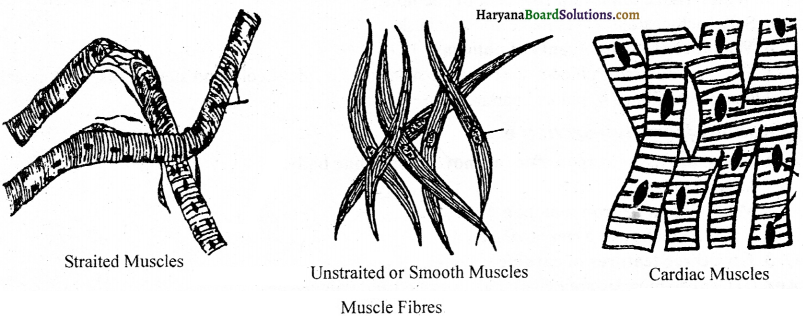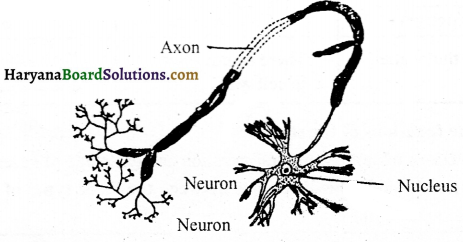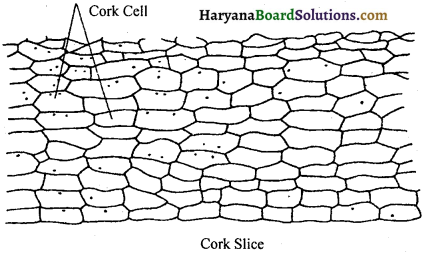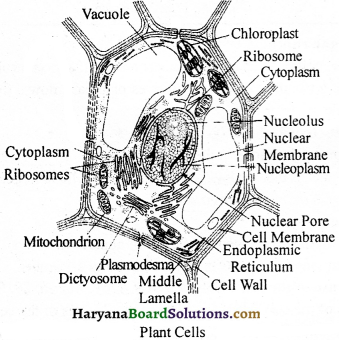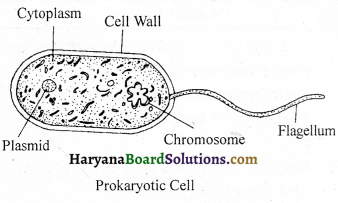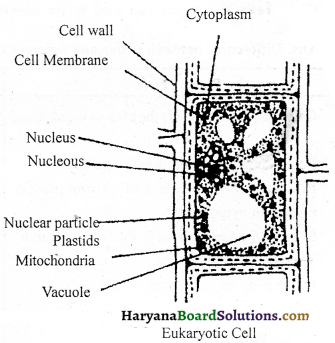Haryana State Board HBSE 9th Class Social Science Solutions Civics Chapter 4 Electoral Politics Textbook Exercise Questions and Answers.
Haryana Board 9th Class Social Science Solutions Civics Chapter 4 Electoral Politics
HBSE 9th Class Social Science Civics Electoral Politics Textbook Questions and Answers
Question 1.
Which of the following statements about the reasons for conducting elections are false?
(a) Elections enable people to judge the performance of the government.
(b) People select the representative of their choice in an election.
(c) Elections enable people to evaluate the performance of the judiciary.
(d) People can indicate which policies they prefer.
Answer:
(a) true
(b) true
(c) false
(d) false.
Question 2.
Which of these is not a good reason to say that Indian elections are democratic ?’
(a) India has the largest number of voters in die world.
(b) India’s Election Commission is very powerful.
(c) In India, everyone above the age of 18 has a right to vote.
(d) In India, the losing parties accept the electoral verdict.
Answer:
(a) The largest number of voters in the world are in China and not in India. On this ground, we can not say that the Indian elections are not democratic.
(b) The fact that the Election Commission is very powerful does not make the Indian elections, democratic.

Question 3.
Match the following:
| A. It is necessary to keep the voters list up to date because |
1. there is a fair representation of all sections of our society |
| B. Some constituen-cies are reserved for SCs.and STs so that |
2. everyone has equal opportunity to elect their re-presentative |
| C. Everyone has one and only one vote so that |
3. all candidates must have a fair chance of compe-ting in elections |
| D. Party in power is not allowed to use government vehicles because |
4. some people may have moved away from the area where they vote last. |
Answer:
| A. It is necessary to keep the voters list up to date because |
4. some people may have moved away from the area where they vote last. |
| B. Some constituen-cies are reserved for SCs.and STs so that |
1. there is a fair representation of all sections of our society |
| C. Everyone has one and only one vote so that |
2. everyone has equal opportunity to elect their re-presentative |
| D. Party in power is not allowed to use government vehicles because |
3. all candidates must have a fair chance of compe-ting in elections |
Question 4.
List all the different election-related activities mentioned in the chapter and arrange them in a time sequence, beginning with the first activity and ending with the last. Some of these activities are given below releasing election manifestos; counting of vote; making of voters list; election campaign; declaration of election results; casting of votes; ordering of re-poll; announcing election schedule; filing nomination.
Answer:
Making of voters list, announcing elections, filing nomination, releasing election manifests, election campaign, casting of votes, ordering re-poll, counting of votes, declaration of election results.

Question 5.
Surekha is an officer in charge of ensuring free and fair elections in an assembly constituency in a state. Describe what should she focus on for each of the following stages of the election”:
(a) Election campaign
(b) Polling day
(c) Counting day.
Answer:
(a) She should focus on the observance of election rules in the election campaigns.
(b) She should focus that all arrangements have been done necessary for polling day.
(c) She should focus on the fact that all arrangements for counting of votes have been done.
Question 6.
The table below gives the proportion of different communities among the candidates who won elections to the US Congress. Compare these to the proportion of these communities in the population of the US. Based on this, would you suggest a system of reservations in the US Congress? If yes, why and for which communities? If no, why not?
|
The proportion of the community (in percent) in the |
|
House of Representatives |
Population of US |
| Blacks |
8 |
13 |
| Hispanics |
5 |
13 |
| Whites |
86 |
70 |
Answer:
A system of representation in the US Congress is required. The whites have a population of 70% while their representation is 86%. Hispanics are 13% of the population while they are only 5% in the US Congress. Similar, though less, representation of blacks is there is the US Congress Democracy demands population be represented, as J. S. Mill had said, proportionately and not disproportionately.
Question 7.
Can we draw the following conclusions from the information given in this chapter? Give two facts to support your position for each of these.
(a) Election Commission of India does not have enough powers to conduct free and fair elections in the country.
(b) There is a high level of popular participation in the elections in our country.
(c) It is very easy for the party in power to win an election.
(d) Many reforms are needed to make our elections completely free and fair.
Answer:
(a) Election Commission should be given enough powers (i) to conduct elections fair and free, (ii) to see that the political parties conduct themselves according to the laws.
(b) (i) Popular participation strengthens democracy; (ii) It helps people attain political education.
(c) (i) Parties do election campaigning; (ii) They issue their election manifestos on the eve of elections.
(d) (i) Election identity cards be issued to stop lake voting; (ii) Money and muscle power need to be discouraged.

Question 8.
Chinappa was convicted for torturing his wife for dowry. Satbir was held guilty of practicing untouchability. The court did not allow either of them to contest elections. Does this decision go against the principles of democratic elections?
Answer:
This decision of the court disallowing Chinappa and Satbir to contest elections is not against the principles of democratic elections. The court has the power to give such a decision.
Question 9.
Here are some reports of electoral malpractices from different parts of the world. Is there anything that these countries can learn from India to improve their elections? What would you suggest in each case?
(a) During an election in Nigeria, the officer in charge of counting votes deliberately increased the votes of one candidate and declared him elected. The court later found out that more than five lakh votes cast for one candidate were counted in favor of another.
(b) Just before the elections of Fiji, a pamphlet was distributed warning voters that a vote for former Prime Minister, Mahendra Chowdhary will lead to bloodshed, This was a threat to voters of Indian origin.
(c) In the US, each state has its own method. of voting, its own procedure of counting, and its own authority for conducting elections. Authorities in the state of Florida took many controversial decisions that favored Mr. Bush in the presidential elections in 2000. But no one could change those decisions.
Answer:
(a) The officer in charge of counting should learn to form the Indian election system that he has no such power. The officer has to see that the votes are counted in an honest manner.
(b) Such a pamphlet is against the democratic spirit. Mahendra Chaudhary was a Fiji citizen, though he was of Indian origin. No one should have the right to dissuade, through threats, voters.
(c) All election rules should be uniform- and should be uniform, applied. This is what is the essence of democracy.

Question 10.
Here are some reports of malpractices in Indian elections. Identify what the problem in each case is. What should be done to correct the situation?
(a) Following the announcement of the elections, the minister promised to provide financial aid to reopen the closed sugar mill.
(b) Opposition parties alleged that their statements and campaign was not given due attention in Doordarshan and All India Radio.
(c) An inquiry by the Election Commission showed that electoral rolls of a state contain names of 20 lakh fake voters..
(d) The hoodlums of a political party were moving with guns, physically preventing supporters of other political parties to meet the voters and attacking meetings of other parties.
Answer:
(a) This is against election rules. After the announcement of elections/announcement of any benefit amounts to influencing the voters. Minister’s activity was against the eligibility norms.
(b) All the political parties, opposition including, should be given due attention by the governmental media. The complaint of the opposition parties was perfectly in order.
(c) Electoral list has to be correctly prepared. Hence fake votes have to be deleted. The preparation of the electoral list has to be done much before the elections.
(d) Muscle power, during the election, is against the eligibility norms. Strict laws should be strictly applied.
Question 11.
Aran was not in class when this chapter was being taught He came the next day and repeated what he had heard from his father. Can you tell Ramesh what is wrong with these statements?
(a) Women always vote the way men tell them to. So what is the point of giving them to right to vote?
(b) Party politics creates tension in society. Elections should be decided by consensus not by competition.
(c) Only graduates should be allowed to stand as candidates for elections,
Answer:
(a) The statement is wrong. Women do not vote, as their men-folk tell them. If they do so, so do the men when their women folk tell them. Should we deny men the right to vote?
(b) The statement is wrong. It is almost impossible to have elections without political parties. Partyless democracy is an impossibility.
(e) The statement is wrong. Giving the
educational qualifications as requisite for contesting elections is not accepted these days.
HBSE 9th Class Social Science Civics Electoral Politics Important Questions and Answers
Question 1.
What is considered as the barometer of democracy?
Answer:
Elections.
Question 2.
What is known as the life-line of the election procedure?
Answer:
The political parities are known as the life line of the election procedure.
Question 3.
Name the state where the National Conference is active in’politics.
Answer:
Jammu and Kashmir.

Question 4.
In which state AI’ADMK is a prominent party?
Answer:
In Tamil Nadu.
Question 5.
What is the name of the Chief Election Commissioner during whose tenure a large number of electoral -reforms were carried out?
Answer:
T. N. Shah.
Question 6.
What are the means Of electronic media?
Answer.
1. Radio
2. Television
3. Cinema.
Question 7.
By whom the election procedure of our country is controlled?
Answer:
By the Election Commission.
Question 8.
What is the election called which is held when Lok Sabha or the State Assembly is dissolved before die expiry of its full term?
Answer:
Mid-term election.
Question 9.
What is meant by an election?
Answer:
An election is a contest that is held between different political parties in order to get people’s support.
Question 10.
On which principle is the system of universal adult franchise based?
Answer:
On the principle of “one person one vote”.

Question 11.
What do you mean by democracy?
Answer:
Democracy is the form of the government “which is elected by the people, ruled by the people and works for the welfare of the people. .
Question 12.
What is meant by political equality?
Answer:
Political equality is the situation every political party has an equal right to fight’ elections.
Question 13.
What is the difference between a party candidate and an independent candidate?
Answer:
A party candidate fights an election on the basis of the principles of the party he belongs. He uses the party .election symbol as his electioti symbol. On the other hand, an independent candidate fights elections on his own principles. He uses the symbol provided, by the Election Commission especially to him.
Question 14.
Why are the symbols allotted to die political parties?
Answer:
The parties are allotted different symbols so that they can haye their distinct identity and a voter can easily identify to which party candidate he is going to vote.
Question 15.
Which political party did Chanudhary Devi Lai.form in 1987?
Answer:
Lok Dal.
Question 16.
Which movement did Chaudhary Devi Lai launch in 1987?
Answer:
Nyaya Yudh.
Question 17.
Which party ruled before the elections in Haryana before 1987?
Answer:
The Congress Party.
Question 18.
Which party formed the government after 1987 elections?
Answer:
The Lok Dal.

Question 19.
Was DeVi Lai very popular at that time?
Answer:
Yes, Devi Lai was very popular at. that time.
Question 20.
Did Lok Dal make arty promises to people?
Answer:
The Lok Dal headed by Devi Lai promised to build a new Haryana.
Question 21.
Did Devi Lai fulfill a promise to waive farmer loans on becoming Chief Minister?
Answer:
Yes, after, becoming Chief Minister, Devi Lai fulfilled the promise he made in the election campaign by passing an order waiving the loans of the
farmers, agricultural laborers, and small shopkeepers.
Question 22.
Devi Lai had not given any manifesto to the people. What are the other means by which people could know about his priorities?
Answer:
Devi Lai’s approach was direct- talking to liis audience.
Question 23.
What are the different methods used by political parties during the election campaign to seek vote?
Answer:
Processions, public meetings, door to door campaign, holding corner meetings, distributing pamphlets, badges etc.
Question 24.
How many seats did the Lok Dal also capture in the 1987 elections?
Answer:
60 seats out of 90; Lok Dal together with Bhartiya Janata Party captured 76 seats.
Question 25.
How many seats did the Congress Party obtain in 1987?
Answer:
5 seats.
Question 26.
Why are elections considered essential for any representative democracy in our times?
Answer:
The elections are considered essential for democracy because of the following reasons:
1. The voters are able to choose who will make laws for them.
2. They can choose who will sit in government and take major decisions.
3. They can choose the party whose ‘ policies will guide the government and law making.
These choices are not made once and for all. In a democratic elections, the people get a chance to make a fresh choice after some time. If they want they can retain the same party’, the same government and the same representatives. But if they are hot, satisfied with the performance of any of these, they can make a change at that level or at all the levels. This ensures that representatives remain answerable to the people.

Question 27.
It is said that elections are about political competition. Explain.
Answer:
Elections are all about political competition. The competition takes various forms. The most obvious form is the competition among political parties. At the level of constituency, it takes the form of competition among several candidates. Very often the competition turns into a personality race among the top leaders of various parties. Elections also involve competition among various policies and ideologies. If there is no competition, there is no point in having elections.
Question 28.
“Political competition provide a system of rewards and punishment”. Discuss.
Answer:
Political competition provides a system of rewards and punishment. It is a system where political leaders are rewarded for good work and punished for not serving the people. It is like school examinations; There is no need for examinations if we could be sure that all the students will study sincerely all the time. But we cannot be sure of that. That is why, We have examinations as a system of rewards and punishment.
Question 29.
A political party won the elections in 1986. Since then no new elections have taken place and that party continues to run the government. Is this country democratic today? Give your reasons to argue for or against it. Why should it be necessary to contest elections again and again?
Answer:
In any democracy, elections have not to be only free and fair, they have to be conducted timely also, A political party, winning the elections and forming the government can not remain in power for ever, nor that country be called democratic. For a country to be called democratic, elections have to be conducted frequently, i.e. at fixed times, and regularly as well.
Question 30.
Based on this account of Haryana. elections, are the following statements correct? Give facts from that example to support what you say.
(a) The party that ruled before the elections and the one that formed government after the elections was the same.
(b) Devi Lai fulfilled his promise to waive farmer loans on becoming chief minister.
(c) People vote. They can vote in support of the existing government or support another party.
(d) Members of the majority party elect their leader. This person becomes the chief minister.
(e) Political parties tell the voters as to what they would do if voted to power.
(f) Political parties make their promises’ known to voters in a statement, called election manifesto.
(g) The contesting parties appeal to voters on the basis of a slogan.
Answer:
(a) No, party that ruled before the elections was the Congress Party; party that ruled after the elections was the Lok Dal
(b) It is correct : Devi Lai fulfilled the promise to waive the farmers’ loans after he took over as the chief minister.
(c) Yes, by voting, the people either support the existing, government or can support another party.
(d) True, the members of the legislature belonging to the majority party elect their leader; the leader is appointed, the chief minister, if the party belongs to a state.
(e) This is done by the political parties by issuing its election manifesto; promises made to the voters.
(f) Correct: this is what the election manifesto does.
(g) This is also true; numerous political parties resort to slogans: Devi Lai used the slogan in 1987; it was ‘Bharashtachar band aur pani ka prabhandh.

Question 32.
What type of legal declaration is given when the nomination form is filled?
Answer:
Every candidate, contesting elections, has to make a legal declaration giving details of:
1. Serious criminal cases.pending against them.
2. Details of their and their family assets and liabilities.
3. Education qualifications.
This system was started after, an important judgment of the Supreme Court of India.
Question 33.
What may be the reason to insist on a detailed statement of assets and liabilities?
Answer:
The reason to insist on a detailed statement of assets and liabilities is to avoid the risk of the candidate’s amassing money through unfair meansr:
Question 34.
Give some of the successful slogans by different political parties in various elections in India in the past.
Answer:
Some of the successful slogans are asunder:
The Congress party led by Indira Gandhi gave the slogan of “Remove Poverty” (Garibi Hatao) in the Lok Sabha elections of 1971. The party promised to recurrent all the policies of the government to remove poverty from the country. “Save Democracy” was the slogan used by Janata Party in the next Lok Sabha election held in 1977.
The party promised to undo the excesses committed during Emergency and restore civil liberties. The Left Front used the slogan of “Land to the Tiller” in the West Bengal assembly elections held in 1977. “Protect the Self-Respect of the Telugus” was the slogan used by N. T. Rama Rao, the leader of the Telugu Desam Party in Andhra Pradesh assembly elections in 1983.
Question 35.
Give details of the election laws which prohibit the candidates when they indulge in election campaign.
Answer:
According to our election laws, no party or candidate can:
1. Bribe or threaten the voters.
2. Appeal to them in the name of caste or religion etc.
3. Use government resources for election campaign.
4. Spend more than Rs. 25 Lakh for a Lok Sabha election or Rs. 10 Lakhs in an assembly election.
If they do so/their election can be rejected by court even after they have been declared elected.
Minimum conditions of a Democratic Elections First, everyone should be able to choose; Everyone can vote and every vote should have equal value. Second, there should be something to choose from. Parties and candidates should be free to contest elections and should offer some real choice to the voters. Third, the voice should be offered at regular intervals. Elections must be held regularly after every few years. Fourth, the candidate preferred by the people should get elected. Fifth, elections should be conducted in a free and fair manner where people can choose as they really wish.

Question 36.
Mention the details about a model code of conduct for the election campaign as agreed by all the political parties in India.
Answer:
The following sum up the Model Code of conduct for the election campaign:
1. Any place of worship shall not be used for election propaganda.
2. Criticisms of the opponents shall be limited to their policies, programs, past records and work and will not mention their personal lives.
3. No flags, banners, notices, or slogans shall be placed on any building without the permission of the owner.
4. government transport including official aircraft, vehicles, machinery and personnel shall not be used by ministers and the ruling party.
5. The ministers shall not lay the foundation stones of any projects or make any promises of providing public facilities after elections have been announced.
Question 37.
Explain Universal Adult Franchise.
Answer:
The Universal Adult Franchise refers to the enjoyment of right to vote by all the adult citizens of the county, without any discrimination i.e., on the basis of caste, creed, colour, sex, education and place of birth. It is a well-known fact that every citizen of India who is 18 years of age and above and who is not otherwise disqualified, is entitled to vote in the elections.
Question 38.
“It is said elections are the barometers of Democracy”. What do you understand by this sentence? ‘
Answer:
In a democratic form of government, tiie elections are considered as barometers of democracy because the elections are very crucial in a democratic set up. Elections provide opportunity to the people to judge the performance of the representatives. Elections also generate a new political attitude which can determine the future course of the country at. large.
Question 39.
Write a short note on the Election Commission.
Answer:
The election commission is the highest body in our country to conduct elections. It not only conducts tire elections but also controls and even supervises this process. All elections to the parliament and to the state legislatures and elections to the offices of the President and the Vice President are conducted by the Election commission. It is the Electipn Commission that fixes and announces the dates of the elections in our country. The Election Commission also makes sure that the party in power does not take undue advantage over other parties.
Question 40.
What is meant by Election Petition?
Answer:
When a candidate is not satisfied about the way the elections have been held in his constituency, he Can file a petition in the court and question the election of another candidate. This kind of petition is’called an election petition. Being accepted, this kind of petition leads to by-election to that particular seat.
Question 41.
What is the importance of the electoral symbols ?
Or
Why that different political parties are given different electoral symbols ?
Answer:
All the political parties as well as the independent candidates also are allotted symbols by the Election Commission. All the major well-Renown political parties have been allotted permanent symbols. These symbols are well-known and quite popular among the public An Indian can easily recognize a Congress candidate by the symbol of palm as well a BJP candidate by the lotus.

Election symbols are allotted mainly, because of the following reasons:
1. These symbols help the ordinary man and even an illiterate to recognise the parties.
2. These symbols help the. political parties to arrange their processions and meetings and carry on their propaganda from street to street.
3. Symbols also help in the situation when there are more than one candidate of the same name in the same constituency
4. In fact symbols make it easy to caste one’s vote.
Question 42.
State briefly the importance of regular electoral competitions.
Answer:
Regular electoral competition provides incentives to political parties and leaders. They know that if they do good work that would make them popular and increase their chaiices of victory in the next elections. But if, they fail to satisfy the voters with their work they will not be able ta win again. So, if a political party or leader was motivated only by desire to be in power and to continue to be so, even then they would be forced to serve the people.
This is a bit like market. Even if a shopkeeper is in terested, only in his profit, he is forced to give good service to the customers, If he does not, the customer will go to some other shop. Similarly, political competition may cause divisions and some ugliness, but it finally, helps to force political parties and leaders to serve the people.
Question 43.
How is tjie election process complete in a country?
Answer:
The following steps are the major ones in the election process in our country:
1. Elections are announced together with their dates for purposes such’as of nomination filling ‘forms, scrutiny etc.,
2. The Election Commission makes sure that the political party in power does not take any undue advantage over other parties.
3. The candidates fill up the nomination papers.
4. The nomination papers or the applications are scrutinized.
5. The candidates not willing to contest any more withdraw their candidature.
6. The final list of the candidates is published. ,
7. Campaigning done by the candidates and their supporters.
8. On the day of the election, casting of votes is performed in a free and fair atmosphere.
9. After the counting, results are announced. Thus, the election procedure in Our country is completed.
Question 44.
Prepare a brief list of the minimum conditions of any democratic elections.
Answer:
The following is the list of minimum conditions in any democratic elections :
1. First, everyone should be able to choose. This means that everyone should have one vote and every vote should have equal value.
2. Second, there should be something to chose from/Parties and candidates should be free to contest elections and should offer some real choice to the voters.
3. Third; the choice should be offered at regular intervals. Elections must be held regularly after every few years,
4. Fourth, whoever people choose should get elected. Elections should be conducted in a free and fair manner where people can choose as they really wish.

Question 45.
Give a brief account of election campaign.
Answer:
The main purpose of an election is to give people a chance to choose the representatives, the government and’ the policies they prefer. Therefore, it is necessary to have a free and.open discussion about who is a better representative, which party will give a better government or what.is a good policy. This is what happens during the election campaigns. In our country, there are two weeks between the declaration of candidates and the polling of votes.
During this period the candidates contact their voters, political leaders address election meetings and political parties mobilise their supporters. This is also, the period when newspapers, and television news are full of election related stories and debates. But election campaign is not limited to the two weeks only. Political parties start preparing for election, months before the election actually takes place.
Question 46.
State briefly some challenges to free and fair election.
Answer:
There are always challenges to free and fair elections. Some of these are:
1. Candidates and parties with a lot of money may not be sure of their victory, but they do enjoy a big and unfair advantage over others.
2. In some parts of the country, candidates with criminal connections have been able to push others out of the electoral race and secure ‘ticket7 from more parties;
3. Very often elections offer little choice to ordinary citizens, for both the major parties are similar to each other and do not wish to raise any major issue;
4. Smaller parties and independent candidates suffer a huge disadvantage compared to bigger parties; and
5; Election campaign often does not raise any basic questions and therefore doeit not offer any real voice to the. people.
Question 47.
What is the importance of the independent Election Commission? How does such a commission help ensure free and fair elections?
Answer:
In our country, elections are conducted by an independent and very powerful Election Commission. A Commission enjoys the same kind of independence that the judiciary enjoys. The Chief Election Commissioner (CEC) is appointed by the President of India. But once appointed the Chief Election Commissioner is not answerable to the President or the government. Even if the ruling party or the government does not like what the Commission does, it is virtually impossible for it to remove the CEC. The Election Commission is a very powerful body.
- Our Constitution gives it tire power to take decisions on every aspect of conduct and control of elections from the declaration of elections to the declaration of .results;
- The Commission lias the pow’er to imple¬ment the Code of Conduct and punish any a candidates or party that violates it;
- During the period of the elections, the EC can order, the government to follow some guidelines, including transferring some government officials like the Collector or SP; and
- When government officers work on elec¬tion duty, they are under the control of the EC and not the government.
Question 48.
Why are certain constituencies reserved and for whom?
Answer:
There are some constituencies which are reserved for people who belong to the Scheduled Castes [SC] and Scheduled Tribes (ST). In reserved (SC) constituency, only someone who belongs to the Scheduled Caste can stand for election. Similarly, only those belonging to Scheduled Tribe can contest. election from a reserved (ST) constituency.
The number of seats so reserved is in proportion to their population. Currently, in the Lok Sabha 79 seats are reserved for the Scheduled Castes and 41 for the Scheduled Tribes. In the panchayat and nagrapalika elections, one-third of the seats are reserved in a similar manner for women candidates. In many states, seats in panchayat and Nagar Palika are reserved for Other Backward Classes as well. This varies from state to state.

Why do we have this system? Isn’t this system unfair to those from other communities? It might seem so. But the gains of this system are mhch bigger. This system makes pur democracy a representative democracy. If there were no system of reservation, very few persons form the Scheduled Castes and Scheduled Tribes would have been elected to the Lok Sabha and Vidhan Sabhas. They would not have had the resources. the education and conditions to contest elections against others.
They would have been discriminated against by others and prevented from winning elections. If that had happened, our parliament and assemblies would have been deprived of the voice of a significant section of our population. In any case the reserved seats do not take away the legitimate share of anyone else. The proportion of seats reserved for Scheduled Castes and Tribes is exactly in proportion to their share in population. In fact, inspired by the success of this system, women’s movement has been demanding a similar system for women as well.
Question 49.
Give a list of slogan raised during elections.
Answer:
In election campaigns, political parties try to focus public attention on some big issues. They want to attract the public to that issue and get them to vote for their party on that basis. Let us look at some oi the successful slogans givne by different political parties in various elections. The Congress party led by Indira Gandhi gave the solgan of Garibi Hatao (Remove poverty) in the Lok Sabha elections of 1971. The party promised to reorient all the policies of the government to remove them. poverty from the country.
Save Democracy was the slogan given by Janata Party in the next Lok Sabha election held in 1977. The party promised to undo the excesses committed during the Emergency and restore civil liberties. The Left Front used the slogan of Land to the Tiller in the West Bengal Assembly elections held in 1977. Protect the Self-Respect of the Telugus was the slogan used by N. T. Rama rao, the leader of the Telugu Desam Party in the Andhra Pradesh Assembly elections in* 1983.
Objective Type Questions
Question 1.
Put (✓) before the correct sentences and (✗) before the incorrect sentences:
(i) The election in our country is conducted by secret ballot.
(ii) The candidates are given a date for withdrawal of their names.
(iii) Elections are the barometers of democracy.
(iv) Radio is a medium of the expression of the. public opinion.
(v) Correct reporting is dependent on the freedom of the press.
(vi) No one can predict the result of an election.
(vii) The influence of the opposition parties spread over the whole country.
Answer:
(i) ✓
(ii) ✓
(iii) ✓
(iv) ✓
(v) ✓
(vi) ✓
(vii) ✗

Question 2.
Complete the following sentences
(i) In 1998, general -elections, …………… formed the government at the center.
(ii) A single party getting the majority or …………… of parties form the government.
(iii) ………….. is the electoral symbol of the Congress.
(iv) The candidates are given a ………… for withdrawal of their names.
(v) Election …………… carry party’s promises about major issues.
(vi) In the general elections of …………… the Congress party was defeated for the first time.
Answer:
(i) Coalition
(ii) Group
(iii) Hand
(iv) Date
(v) Manifestoes
(vi) 1977
Question 3.
Choose the Correct-answer from the alternatives given below:
(i) The following type of Samiti Devi Lai had formed in 1987:
(a) Nyaya
(b) Sanghparash
(c) Vidhan
(d) Sewa
Answer:
(b) Sanghparash
(ii) The Devi Lai Lok Dal party obtained the following number of seats in the Haryana Vidhan Sabha:
(a) 50
(b) 55
(c) 60
(d) 65
Answer:
(c) 60
(iii) The current Lok Sabha strength is:
(a) 540
(b) 541
(c) 542
(d) 543
Answer:
(d) 543

(iv) Currently, the number of the Scheduled Castes seats in the Lok Sabha are:
(a) 76
(b) 77
(c) 78
(d) 79
Answer:
(d) 79
(v) Currently, the number of the Scheduled Tribes in the Lok Sabha is
(a) 41
(b) 42
(c) 43
(d) 44
Answer:
(a) 41

![]()
![]()
![]()
![]()
![]()
![]()
![]()
![]()
![]()
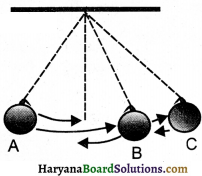
![]()

![]()
